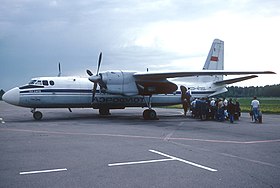Aeroflot flight 1802
| Aeroflot flight 1802 | |
|---|---|
|
Identical aircraft of the airline |
|
| Accident summary | |
| Accident type | Loss of control after excessive rudder deflection |
| place | 14.8 km southeast of Chernihiv , Ukrainian SSR |
| date | May 15, 1976 |
| Fatalities | 52 |
| Survivors | 0 |
| Aircraft | |
| Aircraft type |
Antonov An-24 RW Soviet Union |
| operator |
Aeroflot , Soviet Union |
| Mark | CCCP-46534, Soviet Union |
| Departure airport |
Vinnytsia Airport , Ukrainian SSR |
| Destination airport |
Moscow Bykovo Airport , Russian SFSR |
| Passengers | 46 |
| crew | 6th |
| Lists of aviation accidents | |
On May 15, 1976, an Antonov An-24 had an accident on the internal Soviet scheduled flight Aeroflot flight 1802 from Vinnytsia to Moscow , killing all 52 occupants.
Plane and crew
The aircraft was an Antonov An-24RW (aircraft registration CCCP-46534, serial number : 57310108), which had completed 2976 flight hours and 2328 flight cycles from February 27, 1975 until the accident. She was with two turboprop engines of the type Ivchenko AI-24WT and a flight data recorder equipped type MRSP 12th
The crew consisted of captain Fyodor Ivanovich Tschumak, first officer Viktor Sergeevich Pashchenko, flight engineer Ivan Nikolayevich Wuchan, navigator Pyotr Pavlovich Maksimenko and flight attendants Viktor Vladimirovich Koslow and Nina Nikolayevna Sukalo.
course
The An-24 took off from Vinnytsia at 10:07 a.m. and rose to a cruising altitude of 5,700 m. On the flight route it was cloudy with an upper cloud limit of 5,000–6,000 m with scattered clouds at a height of up to 8,000 m. In addition, there was turbulence at 7,200 m. Near Chernihiv there was rain at 480 m with a wind blowing from the west (250 °) about 22 km / h, while visibility was 10 km. While the aircraft was flying at a speed of 350 km / h, an emergency occurred three minutes after the last radio contact: within a second the rudder deflected 25 ° to the right, whereupon the aircraft rolled and deviated from course. The pilots used the ailerons and the rudder, which was initially deflected, to intercept the rolling motion. Ultimately, the flow stalled and the An-24 went into a tailspin . Eleven seconds after the emergency began, the propeller of the right engine went into sail position and four more seconds later that of the left too. At this point the aircraft was descending at 100 m / s with an acceleration of 1.15-1.2 g . Finally the machine hit with practically no forward speed at 10:48 a.m. with the nose pointing 50 ° downwards and inclined slightly to the right, 1 min 20 s after the rudder deflection. It was intact and the landing gear and landing flaps were retracted. The scene of the accident was in a field approx. 500 m southeast of Viktorivka and 14.8 km southeast of Chernihiv.
root cause
Investigators concluded, based on their investigations, that neither a strong air flow nor military activity, in the absence of any, were responsible for the accident, although the rain clouds with their torrential rains were considered a factor. They found that the rudder was trimmed at 22.5 mm, which ultimately turned it out completely unexpected for the pilots. Due to the degree of destruction caused by the impact and the subsequent fire, the cause of the trim position could not be determined. It is believed that this was caused either by an electrical fault or by accidentally pressing the trim switch by one of the pilots while the autopilot was activated. No switch-on process could be found for this on the flight data recorder, but it is assumed that the autopilot was switched on from approx. 10:29 am; during the sudden rudder deflection it was switched off. The design of the An-24 allowed the trimmed rudder to deflect as soon as the autopilot is deactivated for two seconds and the pilots do not counteract the trim.
additional
The crew were buried in the Baikowe Cemetery in Kiev .
swell
- Accident description (English) An-24RV CCCP-42369 on the Aviation Safety Network , accessed on July 17, 2020
- Description of the accident (Russian) on airdisaster.ru, accessed July 17, 2020
- Description of the accident (Russian) on avia.pro, accessed on July 17, 2020
Coordinates: 51 ° 10 ′ 12 ″ N , 31 ° 15 ′ 0 ″ E
